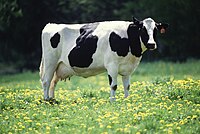
Photo from wikipedia
Aim of the study: To evaluate the association between temperature-humidity index (THI) and body condition score (BCS) at calving and retained placenta (RP), puerperal metritis, clinical ketosis, and mastitis in… Click to show full abstract
Aim of the study: To evaluate the association between temperature-humidity index (THI) and body condition score (BCS) at calving and retained placenta (RP), puerperal metritis, clinical ketosis, and mastitis in Holstein cows in a hot environment Area of study: Northeastern Mexico. Material and methods: This is a retrospective cohort study (n= 12,102 lactations from January 2017 to December 2021) using univariate logistic regressions. The outcome variables were periparturient diseases, and the predictor variables were BCS and thermal stress at calving. Main results: Cows calving with a THI > 82 were 30% more likely (prevalence 16.8% vs 13.7%; p < 0.01) to have RP than cows whose parturition occurred with moderate or low thermal stress (THI < 82 units). Cows calving with THI > 82 had significantly increased chances of having metritis than cows calving with THI < 82 (prevalence 15.6 vs 13.4; p < 0.01). Cows calving with a THI > 82 were 1.8 times more likely to have clinical ketosis (7.6% vs 4.4%; p < 0.01) than cows calving with THI < 82 units. Cows with BCS at calving ≥ 3.5 had half the risk of having RP (prevalence 10.4 vs 19.1%, p < 0.01) than cows with BCS < 3.5. Likewise, the risk of metritis decreased (p < 0.01) with BCS ≥3.5 at calving (prevalence 10.9 vs 17.4%). Research highlights: Heat stress at calving was associated with an increased risk for RP, puerperal metritis, and clinical ketosis compared to cows undergoing mild or no heat stress at parturition. Also, cows with BCS ≥ 3.5 were less likely to present RP and metritis, but high body fatness was associated with an increased risk for clinical ketosis.
Journal Title: Spanish Journal of Agricultural Research
Year Published: 2023
Link to full text (if available)
Share on Social Media: Sign Up to like & get
recommendations!